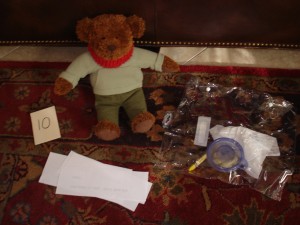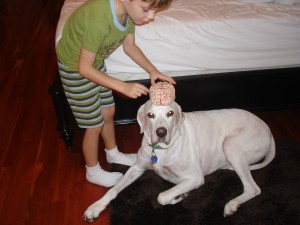Social Skill Building: Â Thinking Beyond One’s Own Needs
One of the things that we are continually working on with Andrew is his social skills.  He is gifted at being able to get everyone around him to meet his wants and needs, even when his speech was limited to “uh uh uhs.”  He is an only child and because we didn’t know what he could or couldn’t do due to his delays, we initially did a lot for him.  Then we hit a point where we realized he could do a lot more but quite enjoyed having others doing things for him while he got to do what he wanted.  Smart child!  (I secretly think he’ll make an excellent business executive someday – he knows what he wants, he’s great at delegating, he checks up to make sure things are getting done the way he wants, and he reaps the rewards of everyone’s hard work.)
You Have To Know What To Do Before You Know What To Do
We learned our lesson but also realized that there were things that he needed to be taught so he would know how to do them. I am a firm believer that you cannot expect someone to know how to do something when they don’t know how to do it. Â I found that this is also true when it comes to empathizing with and helping others with their wants and needs. Â While this might come easily and naturally to some children, it didn’t for him. Â Don’t get me wrong, he is a sweet, happy, loving boy, it just didn’t really occur to him that he should help us or others out. Â We all seemed quite capable of doing it ourselves :). Â I needed a way to teach him this in a very deliberate and direct way without having or needing another person here.
Using What I Already Have
One day, while straightening his room, I put a stuffed animal back on a shelf for the millionth time, and then it hit me! Â I had been focused on building other developmental and academic skills using things I already have and I could do the same to help build the social skills he needs!! Â It was then that I decided to introduce Annie, a teddy bear I had gotten as a baby shower gift. Â I would use her in a My Obstacle Course station activity to help teach him about how to help others.

There were many benefits of working on social skills using an inanimate object. Â I didn’t have to worry about the social skills between two children, him getting overwhelmed by another child’s social expectations or pre-coaching the other child about why we were doing this when it may seem obvious to them. I could model language and actions in a strategic way while within a familiar and safe environment for him. Â This is particularly important for him because he pays attention to and notices everything around him to an amazing degree. Â He picks up on the energy and perceptions that other children have and is quite aware when someone is insulting or making fun of him. Â This was something I wanted to be able to work on without having to add those issues to his plate.
Another benefit was that he would also be able to do things like put on a band-aid or help her brush her teeth without someone squirming (not that friends brush each others teeth but we struggle with getting him to brush his teeth so I wanted him to work on that skill from a different perspective.).  Annie would be perfect for this!
I grabbed Annie and went hunting for some common items that could be useful when helping someone.

Just some of the items I have used:
- tissue
- toothbrush
- straw
- spoon
- band-aid
- crayon
- crackers
I wrote and printed out some basic scenarios that Annie could have happen to her.

Here are some sample scenarios:
- Annie fell down on the playground. Her knee is bleeding. What does she need?
- Annie finished her breakfast and now she needs to brush her teeth. What does she need?
- Annie has applesauce in her lunch. What does she need to help her eat it?
- Annie just sneezed! She needs something to wipe her nose with. What can she use?
- Annie wants to drink her juice but she doesn’t like to drink from the cup. What tool can she use?
When he got to the station, he would have to read or listen to the scenario and find the item in the bag that could help her. Here are some questions that I would ask him:
- What happened to Annie?
- What does she need?
- Can you help her?
When doing this station with him, I was modeling pretend play by treating Annie as though she were a real child sitting there with us. I talked to Annie, modeling for him how to ask her things like, “Are you okay?†or “How can I help you?â€
Turtle Steps
At first it may seem kind of funny (although if you’re in a situation like I was with a non-verbal child, I had already spent years talking out loud to myself so it didn’t really faze me!) and he did look at me like “You do know it’s not real?” but pretty soon he was doing it as well. Â Building these basic social skills did not come over one session but in the 3 years we’ve been doing this, I have really seen them evolve in him. Â Through the use of Annie the Bear, as well as other inanimate friends, and creating different scenarios that were occurring in his life, I think this has made a huge difference. Â It gives him the language to use during a situation that is familiar and he gets to practice without pressure to get it right the first time.


Where at one point in time I could not have imagined him pretend playing with his toys, I have gone looking for him only to find him in his room reenacting scenes from school and home, caring for and nurturing his toys as “real life” people.

This has also moved beyond toys to him commenting on other people’s feelings and needs. Â Just the other day, I hit my shin and said, “Ouch!” Â He ran over and said, “Mommy needs a band-aid.” Â He ran off and yelled for me to come help him because the band-aids were on the top shelf. Â It’s the thought that counts here and he was thinking it!
Engage, Encourage and Empower